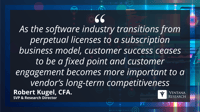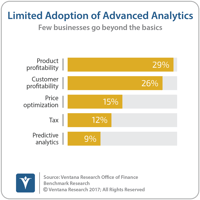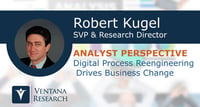One of the challenges of being a practically minded technology analyst is squaring the importance of “the next big thing” with the reality of what most organizations are doing. For decades it’s been the case that “the next big thing” in the world of information technology is easily several years ahead of where most organizations are in their use of technology. And before most organizations can realize the benefit of some whiz-bang technology, they frequently need to address a range of more...
Read More
Topics:
Human Capital Management,
Marketing,
Office of Finance,
Analytics,
Business Intelligence,
Sales Performance Management,
Financial Performance Management,
Price and Revenue Management,
Digital Marketing,
Work and Resource Management,
Digital Commerce,
Operations & Supply Chain,
Enterprise Resource Planning,
ERP and Continuous Accounting,
robotic finance,
Predictive Planning,
revenue and lease accounting,
Subscription Management,
intelligent sales,
AI & Machine Learning
By itself, data isn’t useful for business; the application of analytics is necessary to transform data into actionable information. Data analysis of one sort or another has long been a core competence of finance departments, applied to balance sheets, income statements or cash flow statements. Today, however, Finance must go beyond these basics by expanding the scope of the data being examined to include all financial and operational information that can yield actionable insights. Analysis thus...
Read More
Topics:
Customer Experience,
Human Capital Management,
Marketing,
Voice of the Customer,
business intelligence,
embedded analytics,
Learning Management,
Analytics,
Collaboration,
Data Governance,
Data Lake,
Data Preparation,
Information Management,
Internet of Things,
Contact Center,
Data,
Product Information Management,
Sales Performance Management,
Workforce Management,
Financial Performance Management,
Price and Revenue Management,
Digital Technology,
Digital Marketing,
Digital Commerce,
ERP and Continuous Accounting,
blockchain,
natural language processing,
robotic finance,
Predictive Planning,
candidate engagement,
Intelligent CX,
Conversational Computing,
Continuous Payroll,
revenue and lease accounting,
collaborative computing,
mobile computing,
Subscription Management,
agent management,
extended reality,
AI & Machine Learning
“Platform,” as used in the world of technology, originally referred to an operating system on which one could construct software applications. More recently, its usage has been expanded to apply to two types of business models. One enables third parties to create products and services that are complementary to a company’s core technology. For instance, both Apple and Salesforce have attracted a wide array of third-party software developers whose offerings greatly increase the value of each...
Read More
Topics:
Human Capital Management,
Marketing,
Office of Finance,
Voice of the Customer,
Continuous Planning,
Information Management,
Internet of Things,
Workforce Management,
Financial Performance Management,
Price and Revenue Management,
Digital Marketing,
Digital Commerce,
Operations & Supply Chain,
Enterprise Resource Planning,
ERP and Continuous Accounting,
robotic finance,
Predictive Planning,
revenue and lease accounting,
collaborative computing,
continuous supply chain
PROS Holdings is a software vendor with two distinct but related sets of products. The company began in 1985 offering revenue management software to airlines, hospitality and rental car companies. More recently it added price and revenue management software focusing on B2B services, chemicals and energy, consumer goods manufacturers, food and beverage, healthcare, insurance and technology. This note focuses on the B2B portion of the business.
Read More
Topics:
Big Data,
Sales,
Customer Experience,
Marketing,
Office of Finance,
Analytics,
Data Preparation,
Sales Performance Management,
Financial Performance Management,
Price and Revenue Management,
Digital Marketing,
Digital Commerce,
Pricing and Promotion Management,
Sales Enablement and Execution
Blockchains are attractive because their built-in security and trust factors make them useful for almost all business interactions involving organizations and individuals. Blockchains have two basic functions. One is as a method for handling transactions involving property such as land deeds, trademarks or other assets. The second involves exchanges of data such as identities of individuals or businesses, the location of an object at a point in time or weather conditions. All interactions...
Read More
Topics:
Big Data,
Data Science,
Mobile,
Marketing Performance Management,
Office of Finance,
Analytics,
Business Intelligence,
Cloud Computing,
Data Governance,
Data Integration,
Data Preparation,
Internet of Things,
Digital Technology,
Digital Marketing,
Digital Commerce,
Operations & Supply Chain
Oracle recently held its second ERP Cloud Summit with industry analysts. The all-day event wasn’t just about ERP. The company covered a range of its business applications, including financial performance management as well as its Adaptive Intelligent Applications. And it wasn’t just about the cloud. After more than a decade of steady developments, ERP systems have begun to change fundamentally, facilitated by the growing availability of new technologies including cloud computing, advanced...
Read More
Topics:
Big Data,
Data Science,
Mobile,
Customer Experience,
Human Capital Management,
Machine Learning,
Office of Finance,
Analytics,
Data Integration,
Internet of Things,
Cognitive Computing,
HRMS,
Financial Performance Management,
Mobile Marketing Digital Commerce,
Digital Marketing,
Digital Commerce,
Operations & Supply Chain,
Enterprise Resource Planning,
ERP and Continuous Accounting
Business process reengineering was a consulting fashion in the early 1990s that spurred many companies to purchase their first ERP systems. BPR proposes a fundamental redesign of core business processes to achieve substantial improvements in market and customer responsiveness, productivity, cycle times and quality. ERP systems support business process reengineering by guiding the step-by-step execution of the redesigned process to ensure that it is performed consistently. They also automate the...
Read More
Topics:
Big Data,
Data Science,
Mobile,
Customer Analytics,
Customer Experience,
Machine Learning,
Office of Finance,
Wearable Computing,
Continuous Planning,
business intelligence,
Analytics,
Cloud Computing,
Data Integration,
Internet of Things,
Financial Performance Management,
Digital Technology,
Digital Marketing,
Digital Commerce,
Operations & Supply Chain,
Enterprise Resource Planning,
Machine Learning and Cognitive Computing,
ERP and Continuous Accounting,
Sales Planning and Analytics

















